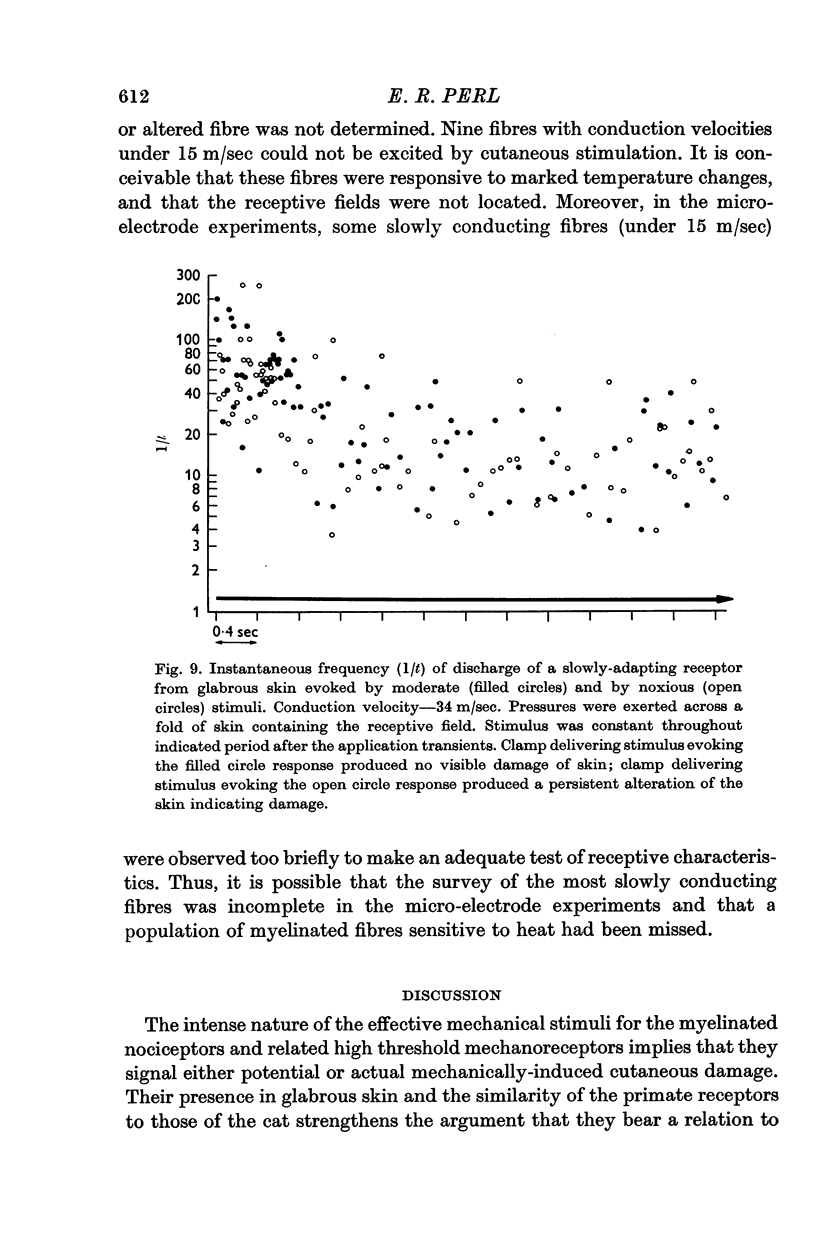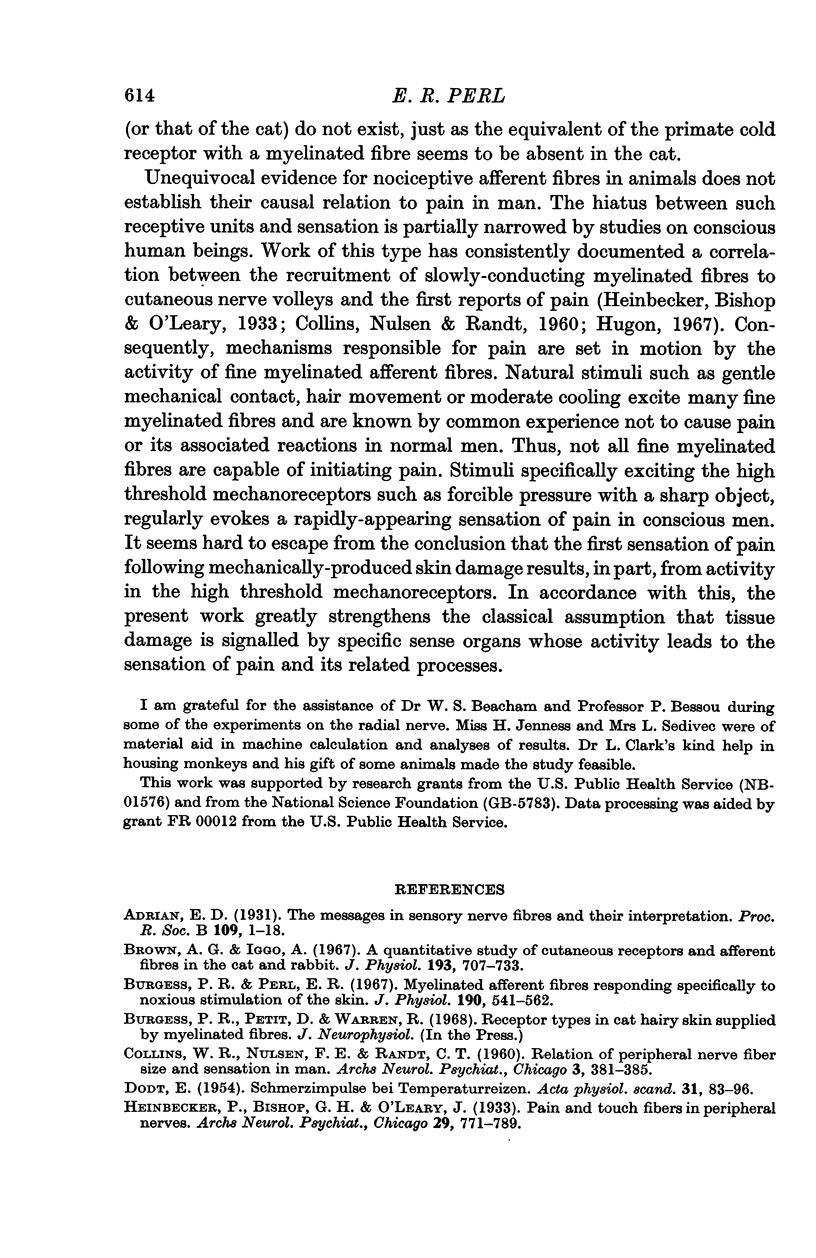Abstract
1. The functional characteristics of cutaneous receptors in the squirrel monkey were determined by recording discharges of single myelinated afferent fibres in peripheral nerves with micro-electrodes or from fine filaments prepared by dissection. One hundred and sixty-nine fibres of the posterior femoral cutaneous nerve and 209 of the superficial radial nerve with conduction velocities between 4 and 88 m/sec were classified according to the nature of the most effective stimulus, discharge characteristics, adaptation rate and organization of the receptive field.
2. Twenty per cent of the fibres innervating either hairy or glabrous skin required strong mechanical stimuli for activation; thresholds ranged from moderate to overtly damaging pressures. This class showed little or no sensitivity to thermal changes including noxious heat. Their receptive fields consisted of numerous, mechanically-excitable points or spots. All such fibres gave higher impulse frequencies to noxious than to innocuous mechanical stimuli and a large fraction were considered to be nociceptors because they responded only to noxious deformation. The conduction velocities of nociceptors were distributed between 5 and 28 m/sec.
3. All but a few of the other fibres encountered responded vigorously to innocuous stimuli and were readily identified as corresponding to one of the receptor types known to exist in either the primate or the cat. These sensitive receptors were systematically tested by intense cutaneous stimuli; their response to injurious stimuli always could be mimicked by innocuous ones.
4. Therefore, in the primate a particular class of slowly-conducting myelinated fibres is partially responsible for signalling mechanically-induced cutaneous damage. The probable relation between such afferent fibres and certain kinds of cutaneous pain is explored.
Full text
PDF






















Selected References
These references are in PubMed. This may not be the complete list of references from this article.
- Brown A. G., Iggo A. A quantitative study of cutaneous receptors and afferent fibres in the cat and rabbit. J Physiol. 1967 Dec;193(3):707–733. doi: 10.1113/jphysiol.1967.sp008390. [DOI] [PMC free article] [PubMed] [Google Scholar]
- Burgess P. R., Perl E. R. Myelinated afferent fibres responding specifically to noxious stimulation of the skin. J Physiol. 1967 Jun;190(3):541–562. doi: 10.1113/jphysiol.1967.sp008227. [DOI] [PMC free article] [PubMed] [Google Scholar]
- COLLINS W. R., Jr, NULSEN F. E., RANDT C. T. Relation of peripheral nerve fiber size and sensation in man. Arch Neurol. 1960 Oct;3:381–385. doi: 10.1001/archneur.1960.00450040031003. [DOI] [PubMed] [Google Scholar]
- DODT E. Schmerzimpulse bei Temperaturreizen. Acta Physiol Scand. 1954 Jun 21;31(1):83–96. doi: 10.1111/j.1748-1716.1954.tb01116.x. [DOI] [PubMed] [Google Scholar]
- HENSEL H., BOMAN K. K. Afferent impulses in cutaneous sensory nerves in human subjects. J Neurophysiol. 1960 Sep;23:564–578. doi: 10.1152/jn.1960.23.5.564. [DOI] [PubMed] [Google Scholar]
- HUNT C. C., McINTYRE A. K. An analysis of fibre diameter and receptor characteristics of myelinated cutaneous afferent fibres in cat. J Physiol. 1960 Aug;153:99–112. doi: 10.1113/jphysiol.1960.sp006521. [DOI] [PMC free article] [PubMed] [Google Scholar]
- HUNT C. C. On the nature of vibration receptors in the hind limb of the cat. J Physiol. 1961 Jan;155:175–186. doi: 10.1113/jphysiol.1961.sp006621. [DOI] [PMC free article] [PubMed] [Google Scholar]
- IGGO A. Cutaneous heat and cold receptors with slowly conducting (C) afferent fibres. Q J Exp Physiol Cogn Med Sci. 1959 Oct;44:362–370. doi: 10.1113/expphysiol.1959.sp001417. [DOI] [PubMed] [Google Scholar]
- IGGO A. Cutaneous mechanoreceptors with afferent C fibres. J Physiol. 1960 Jul;152:337–353. doi: 10.1113/jphysiol.1960.sp006491. [DOI] [PMC free article] [PubMed] [Google Scholar]
- IGGO A. TEMPERATURE DISCRIMINATION IN THE SKIN. Nature. 1964 Oct 31;204:481–483. doi: 10.1038/204481a0. [DOI] [PubMed] [Google Scholar]
- IRIUCHIJIMA J., ZOTTERMAN Y. The specificity of afferent cutaneous C fibres in mammals. Acta Physiol Scand. 1960 Jul 15;49:267–278. doi: 10.1111/j.1748-1716.1960.tb01952.x. [DOI] [PubMed] [Google Scholar]
- Kenshalo D. R., Gallegos E. S. Multiple temperature-sensitive spots innervated by single nerve fibers. Science. 1967 Nov;158(3804):1064–1065. doi: 10.1126/science.158.3804.1064. [DOI] [PubMed] [Google Scholar]
- MARUHASHI J., MIZUGUCHI K., TASAKI I. Action currents in single afferent nerve fibres elicited by stimulation of the skin of the toad and the cat. J Physiol. 1952 Jun;117(2):129–151. doi: 10.1113/jphysiol.1952.sp004736. [DOI] [PMC free article] [PubMed] [Google Scholar]
- MELZACK R., WALL P. D. On the nature of cutaneous sensory mechanisms. Brain. 1962 Jun;85:331–356. doi: 10.1093/brain/85.2.331. [DOI] [PubMed] [Google Scholar]
- Melzack R., Wall P. D. Pain mechanisms: a new theory. Science. 1965 Nov 19;150(3699):971–979. doi: 10.1126/science.150.3699.971. [DOI] [PubMed] [Google Scholar]
- WITT I., HENSEL H. Afferente Impulse aus der Extremitätenhaut der Katze bei thermischer und mechanischer Reizung. Pflugers Arch. 1959;268(6):582–596. doi: 10.1007/BF00362294. [DOI] [PubMed] [Google Scholar]
- Zotterman Y. Touch, pain and tickling: an electro-physiological investigation on cutaneous sensory nerves. J Physiol. 1939 Feb 14;95(1):1–28. doi: 10.1113/jphysiol.1939.sp003707. [DOI] [PMC free article] [PubMed] [Google Scholar]


